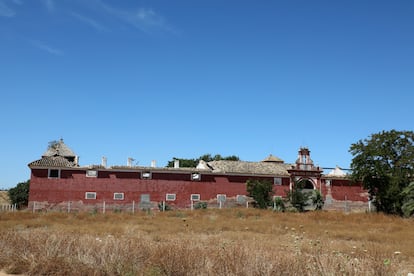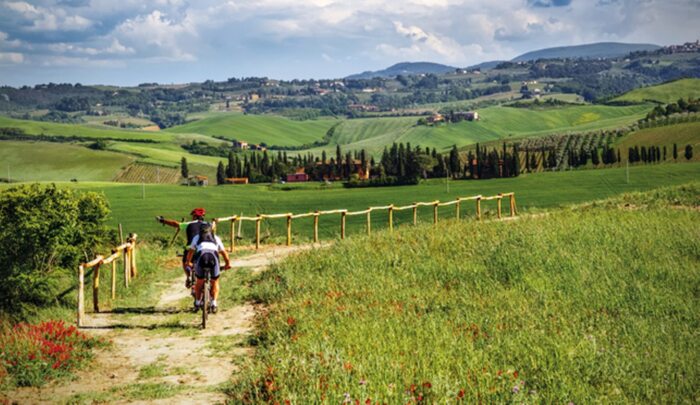Ana Luque and Ángela Adrover have bought and rehabilitated an abandoned vineyard house in El Puerto to turn it into their home and rural accommodation."JUAN CARLOS TORO"
The El Peral hacienda is still the same one that in the early morning of January 2, 1820 gave lodging to the tired and rain-soaked troops of General Rafael Riego.
There are still its two beautiful dovecote towers painted with almagre, its large patio and its wheels for grinding oil.
Even in his deeds, the surname Martell continues to appear, the same name of the one who lodged Riego just after beginning his pronouncement in Las Cabezas de San Juan (Seville).
But everything around him has changed.
Its silhouette, almost that of a fortress, can now be glimpsed fleetingly through the window of any car that circulates through the connection hub of the A-382 motorway, as it passes through Arcos (Cádiz).
Although it is still agricultural, it is no longer surrounded by olive groves.
Like El Peral, 2,225 farmhouses, haciendas, wineries and vineyard houses are scattered throughout Andalusia,
immersed in a crossroads of uncertain end.
So historical and identity as to be protected cultural elements;
so huge and rural as to survive at the mercy of agricultural uses in clear decline that force them to reconvert or end up stranded in the middle of nowhere between abandonment and ruin.
Ángela Adrover and Ana Luque are aware of how contradictory the story of their history as recent owners of one of those rural buildings can be.
"If I went back to the beginning knowing the cost, I wouldn't do it," explains the first.
A string of tedious bureaucratic obstacles and reforms that were more expensive than expected complicated the dream of this couple of tax advisers of buying a typical vineyard house in the Marco de Jerez to live in.
But now that they see themselves living with their son in that 19th-century building in El Puerto de Santa María, converted into rural accommodation, a meeting space and an ecological winery, they are clear that theirs is, above all, "a life project", as Adrover immediately emphasizes.
Now his house and business is called La Bendita Locura in honor of the "you're crazy" that many blurted out to those who narrated his plan,
This is how it appears registered in
Cortijos, Haciendas and Lagares de Andalucía
, a catalog that involved more than 20 architects and specialists for 11 years (from 1991 to 2002) in the quantification, study and analysis of the 2,225 large buildings that still populate the Andalusian countryside, commissioned by the current Ministry of Development of the Board of Andalusia.
The architect José Manuel Aladro, one of the editors of the manual, explains: “We must be aware of their heritage importance, not only as buildings.
Agrarian architecture is part of our cultural identity.
It speaks of a way of life, a relationship of man with his territory”.
In fact, his work served to reconstruct the history and typologically characterize these constructions, as diverse as the function they serve or the area in which they are located.
Little or nothing has to do a winery with a house of vineyards;
even two types of identical buildings, such as a hacienda, are different depending on whether they are built in the western or eastern part of the region.
However, they all share elements typical of Andalusian or Extremaduran popular vernacular architecture, such as the use of lime (for finishes and mortar), brick or tile.
And transversal architectural resources, such as the whiteness of its finishes and its articulation around a central patio, according to the architect.
Until the team of experts that made up Aladro began to visit and catalog all these characteristics, a good part of the town councils did not notice their value.
“As a result of the preparation of the inventory, most of the municipalities began to protect them and incorporate them into their general plans,”
The Ibarburu farm (Dos Hermanas), included by the Hispania Nostra association in its Red Heritage List, due to its neglect and threat of ruin.Jose Manuel Baena
All this has not saved more than one of these constructions from abandonment and ruin, accelerated by agricultural changes and rural depopulation.
The art historian José Manuel Baena Gallé noticed the problem while visiting the imposing Ibarburu hacienda (Dos Hermanas), an exceptional example of both rural and palatial architecture dating from 1748, which today is being consumed amid looting and landslides.
Neither its nobility nor its cataloging with the maximum protection of Asset of Cultural Interest (2002) have prevented the Hispania Nostra association from including it, last September, in its Red Heritage List, due to the arson attacks and “the loss of 70% of their roofs”, details Baena.
“If it has come to this, it is due to lack of uses.
Agriculture and livestock have changed and that can be positive,
Concerned about Ibarburu's neglect, Professor Baena wrote last year the article
Rural heritage and climate change
in the Andalusian heritage magazine
PH
, in which he discusses how the alteration of the environment is impacting against this ethnological heritage.
"If we go from extensive olive groves to sunflowers, it affects the type of fauna, pollination, how the climate is related to the soil and temperatures change," details the historian, in relation to some buildings that end up stripped of the destination for which they were conceived.
This, added to the loss of profitability of the farms and the high maintenance costs of the buildings, has led to a presumed loss of Andalusian haciendas and farmhouses that is unknown.
More than 20 years after the catalog counted 2,225 buildings, the Ministry of Development admits to this newspaper that it does not plan to update it to know its current status.
What's more,
With these wickers, Francisco Martell does what he can at his El Peral hacienda, known for that ranch of General Riego, although today nothing remembers him in the area.
“It's pretty bad.
I am fixing what I can, but I am focused on the agricultural modernization of the farm”, explains the owner, who inherited it from his father two years ago in a family saga that dates back to the 19th century.
Although the two dovecote towers that characterize it are, in truth, counterweights of two beam presses, oil has not been produced there for decades.
Now it serves wheat, sunflower, broad bean or chickpea crops, despite the fact that Martell can barely use one of the warehouses, the only one in which the machinery fits.
All in all, the owner is determined in his desire to give the building new uses in the future: “Something will have to be done, I don't know what.
If the agricultural theme did not exist, that would fall.
Everything is possible, but in the end you have to have money”.
The house of vineyards of San Cayetano, in Jerez de la Frontera.
JUAN CARLOS BULL
Despite this number of obstacles that complicate conservation and cases of abandonment, Agustín García Lázaro, an expert in the rural heritage of Jerez, assures that he warns of “a return to the countryside among the owners, to fix these farmhouses, to diversify uses, who has possibility is going back to that.”
The specialist gives the example of the La Peñuela farm or the Espanta Rodrigo farmhouse, two restored Cadiz farms that have been able to combine livestock and agricultural activities with the organization of large events, such as weddings.
And there are more success stories, such as that of the Sevillian hacienda Guzmán, specialized in the increasingly thriving oil tourism.
That diversity of opportunities was what ended up convincing Adrover and Luque.
Four years after starting their adventure and investing 1.2 million euros —174,000 euros, from European Feder funds—, the couple has gone further than they thought.
In addition to their charming three-bedroom rural accommodation, they have rooms for events and have even launched into producing organic wine, which they offer in wine tourism visits with tastings.
"Our idea was not to live from it, now we are considering leaving the consultancy and dedicating ourselves only to this", Adrover points out.
Aladro is aware that cases of new lives and uses such as La Bendita Locura are not always possible, since there is no capacity for all those houses that cut out the Andalusian countryside horizon to be exploited as rural tourism.
But he minimizes the mistrust of those changes that seem to be the only possible lifesaver, once the benefits of the field are no longer what they were.
The architect Aladro ditches with hope: “Neither can we maintain all the palaces and convents for what they were conceived, nor can we maintain all the agrarian architecture for what it worked for.
Do not be afraid of reuse.
But we do have to be aware of what we are intervening so that his memory is not lost”.



/cloudfront-eu-central-1.images.arcpublishing.com/prisa/YX5RQ7D2UFG4TBMGC37OIAGRB4.jpg)

/cloudfront-eu-central-1.images.arcpublishing.com/prisa/NNVFZ5YYUREELOYYJCKKCEOORE.jpg)
/cloudfront-eu-central-1.images.arcpublishing.com/prisa/S4BTGDA7TFEMFBJYT4VGJQNXEY.jpg)
/cloudfront-eu-central-1.images.arcpublishing.com/prisa/GABYBHS4YFHQHCNMDHNWKW6QZ4.jpeg)
/cloudfront-eu-central-1.images.arcpublishing.com/prisa/RXCNJX5B6ZG3VAZXWMSTFR4AYQ.jpg)






